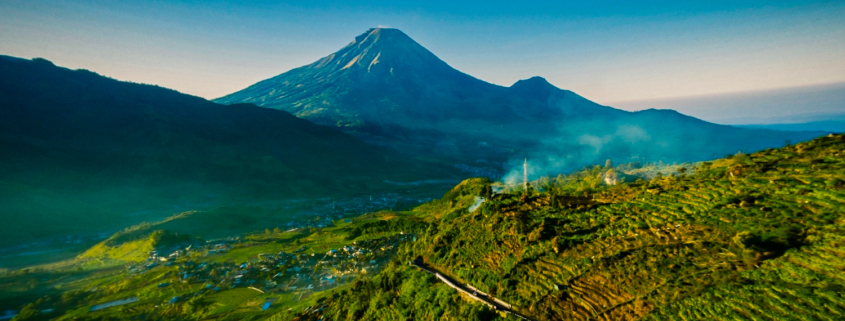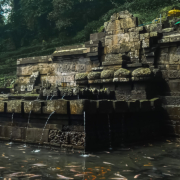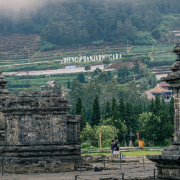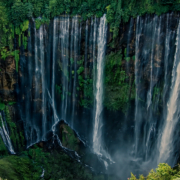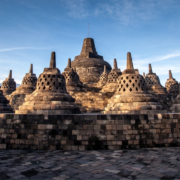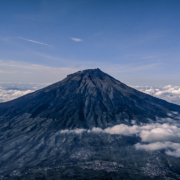Dieng Plateau: The Mystical Highlands of Central Java
Floating over 2,000 meters above sea level in the misty highlands of Central Java, the Dieng Plateau is a destination unlike any other—a surreal volcanic landscape where sacred temples, bubbling craters, sulfurous lakes, and ancient myths coexist in an ethereal dream. Often referred to as the “Abode of the Gods” (Di Hyang in Old Javanese), Dieng is one of Indonesia’s oldest spiritual and geological sites, offering an experience that blends natural wonder, cultural heritage, and mystical charm.
A Volcanic Wonderland in the Clouds
The Dieng Plateau lies within a massive ancient caldera, surrounded by the majestic peaks of Mount Prau and Mount Sindoro. The region is still volcanically active, giving rise to an otherworldly topography of steaming vents, boiling mud pots, and shifting sulfuric lakes.
From the vivid green fields of potatoes and cabbages to the haunting mist that clings to its temples and hills, Dieng feels like a floating world, cut off from the modern bustle below.
Top Natural & Cultural Attractions
1. Arjuna Temple Cluster
- Some of the oldest Hindu temples in Java, dating back to the 7th–8th centuries.
- Dedicated to Shiva and surrounded by smaller shrines with minimalistic yet sacred architecture.
- Often shrouded in morning mist, giving the complex a timeless, mystical aura.
2. Sikidang Crater
- A steaming volcanic crater with bubbling mud and the scent of sulfur in the air.
- Named after a mythical deer (kidang) said to jump from place to place, much like the crater’s shifting vents.
- Visitors can walk near the edge on boardwalks and experience the raw, elemental energy of Java’s volcanic forces.
3. Telaga Warna (Color-Changing Lake)
- A beautiful lake known for its shifting hues of turquoise, green, and gold, caused by sulfuric mineral content.
- Surrounded by dense forest and myth-laden caves, such as Goa Semar and Goa Jaran, used for meditation and spiritual rituals.
- Believed to hold spiritual significance in Javanese cosmology, often associated with transformation and soul healing.
4. Rambut Gimbal Tradition
- Unique cultural practice in which local children with naturally dreadlocked hair (anak gimbal) are honored as sacred.
- Their hair is ceremonially cut during the Dieng Culture Festival, believed to bring balance to both the child and community.
- A rich intersection of ancestral belief, animism, and Hindu-Javanese spiritual fusion.
Activities & Experiences
- Trekking to Mount Prau for sunrise panoramas across Java’s volcanic skyline.
- Camping under the stars, where clear skies reveal brilliant constellations.
- Soaking in thermal springs like Kalianget or Bima Lukar to relax and rejuvenate.
- Sampling local delicacies like carica (a Dieng papaya), purwaceng (herbal energy tonic), and jamu made from mountain herbs.
Climate & Ambiance
Dieng is one of the coldest inhabited regions in Java, with temperatures dropping near freezing during the dry season (June–August). The plateau’s crisp mountain air, morning frost, and misty hills add to its mystical atmosphere.
This climate nurtures rare phenomena like frozen grass (“embun es”), which draws photographers and travelers during the “mini winter” that occurs in the high dry months.
Accessibility & Travel Tips
- Location: Between Wonosobo and Banjarnegara, Central Java
- Access: 3–4 hour drive from Yogyakarta or Semarang via Wonosobo
- Best Time to Visit: May to September for dry weather and festivals
- What to Bring: Warm clothes, hiking shoes, and camera for surreal landscapes
Dieng Plateau is not just a destination—it is a realm of elemental energy, sacred memory, and timeless beauty. It invites travelers to step into a highland dimension where earth, fire, water, and spirit dance in harmony. From ancient stone temples whispering tales of forgotten dynasties, to sulfurous lakes that reflect the changing soul of the sky, Dieng is Central Java’s spiritual roof—a place to explore, reflect, and remember.
Whether you’re a nature lover, spiritual seeker, cultural explorer, or curious wanderer, Dieng welcomes you into its mist—ready to unveil its ancient secrets and heavenly silence.

